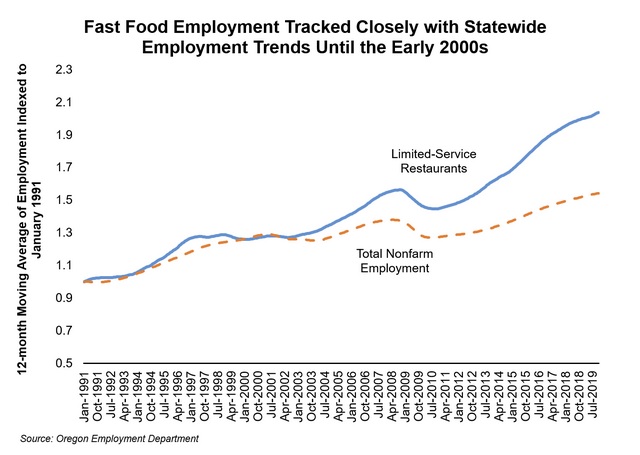
By by Damon Runberg
Oregon Employment Department,
Oregon welcomed its third In-N-Out Burger to much fanfare, long lines, and in some instances, upwards of a two-hour wait for a fast food burger. Although fans of the burger chain would claim that In-N-Out is not your traditional fast food restaurant, it is nonetheless, included in the limited-service restaurant sector, which is comprised of fast food restaurants, sandwich shops, and pizza parlors. Is this excitement over the new In-N-Out location in Keizer a reflection of the broader popularity of these limited-service restaurants (fast food) in Oregon? Or, are folks just really excited about In-N-Out?
In November 2019 there were roughly 72,000 jobs in limited-service restaurants in Oregon. Although that is a significant number of jobs, it only represents around 3.7 percent of total nonfarm jobs across the state. In fact, the concentration of limited-service restaurant jobs in Oregon is lower than the national average by roughly 10 percent. If fast food is particularly popular in Oregon, it isn’t translating into a high concentration of fast food jobs.
When looking across the metro areas in the state, we see that the share of employment in these limited-service restaurants is fairly consistent with the national average. The Portland metro area has a notably lower share of employment in these types of fast food restaurants (~14% lower than the national average). On the other end of the spectrum the Eugene, Corvallis, and Grants Pass metro areas have a higher share of employment in these businesses than the national average. In the case of Eugene and Corvallis, their share of employment in fast food restaurants is likely higher due to the presence of a major university.
Despite the fact that employment levels in these limited-service restaurants is relatively low compared with the national average, it is a growing sector that is outpacing broader job growth. Over the past year employment in limited-service restaurants increased by 2.1 percent, slightly faster than the 1.6 percent growth in total nonfarm employment. However, long-term growth is much more pronounced. The sector expanded by nearly 22 percent over the past five years (+12,700 jobs) and 38.5 percent over the past decade (+19,775 jobs), significantly faster growth than the broader statewide economy during the same time periods. Interestingly, the sector largely grew in-step with the statewide economy up through 2001. Since the early 2000s, these fast food restaurants have grown faster than the statewide economy. What changed in 2001 that led to fast food restaurants outpacing the broader economy? Are we becoming increasingly impatient when it comes to waiting for our food? I have no idea.
The demand for limited-service restaurant workers is not particularly high across the state. According to the Conference Board Help Wanted Online, the majority of the job ads for these workers in the past 90 days were in the Portland metro area (412 unique ads), but that represents a much smaller share of total job ads compared with the national average. The only metro area in the state that posted a share of fast food job ads consistent with the national average was the Salem area, which posted 65 job ads over the past 90 days. That likely reflected the impact of the new In-N-Out opening.
Oregonians may be In-N-Out fans, but they aren’t necessarily fast food fanatics. Despite the rapid growth in fast food employment over the past decade, we continue to see lower shares of employment than the national average in most parts of the state.
Disclaimer: Articles featured on Oregon Report are the creation, responsibility and opinion of the authoring individual or organization which is featured at the top of every article.


